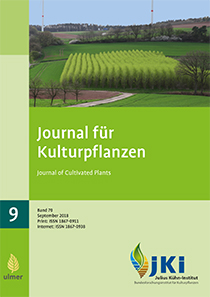Impact of perennial and anual crops on arthropod communities – dynamics and driving forces within agro – ecosystems
DOI:
https://doi.org/10.5073/JfK.2018.09.01Keywords:
perennial and annual crops, Arthropod community, associations, population dynamics, energy gain, energy input, intensity, food web, environmental sustainabilityAbstract
Investigations with pitfall traps into the influence of crop species on the dynamics of arthropod communities are presented. They included four perennial crops (extensive grassland, miscanthus and poplar and willow tree species) as well as winter barley as annual crop. The cultivars determined the diversity (Shannon-Weaver-Index) of arthropod communities, whereby the diversity of the tree species was mostly statistically different from the diversity in agricultural crops. This finding was due to temporal changes in the species stock (species identity) and the species dominance (dominance identity) and demonstrates high dynamics of arthropod presence within and between crops. The crop species lead to temporally and locally separated metapopulations. Possible driving forces stimulating the adaptation of arthropod communities to crops were analyzed by recording the energy status of the cropping systems. It was based on management data, plant yields and accompanying information about biomass accumulation. The term “agricultural energy gain” summarizes these influences on the energy level. The return of biomass to the cultivation system was described as “ecosystem energy gain”. Both parameters elucidate the arthropod presence within the crops. Increasing agricultural energy gain was negatively related in contrast to the energy gain of the entire ecosystem. Furthermore, the splitting of arthropods into functional groups helped to explain the species and dominance variation of arthropod communities between crops. This is based on the need for energy dissipation and influences the energy flow across trophic levels. The position of arthropod species within the food web gets modified. The results show that energy-based data serve to evaluate the biodiversity status of cropping systems. They can be the basis for derivation of indirect status or impact indicators. In addition, the findings promote the understanding of ecosystem processes and the meaning of “intensity” in the context of ecologically sustainable land use.
Downloads
Published
Issue
Section
License
The content of the journal is licensed under the Creative Commons Attribution 4.0 License. Any user is free to share and adapt (remix, transform, build upon) the content as long as the original publication is attributed (authors, title, year, journal, issue, pages).
The copyright of the published work remains with the authors. The authors grant the Journal of Cultivated Plants, the Julius Kühn-Institut and the OpenAgrar repository the non-exclusive right to distribute and exploit the work.







